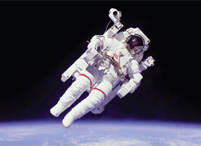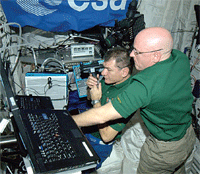Astronauts who are in space six months or longer may experience a variety of changes to their vision—some that last long after they return to Earth, according to a study in the October issue of Ophthalmology. A research team looked at seven astronauts who were about 50 years old and had spent at least six continuous months in space. All the astronauts reported blurry vision while on the space station.

Nearly two-thirds of astronauts on long-term missions develop visual problems.
Photo: NASA.
These findings confirm an earlier NASA post-flight survey of about 300 astronauts. Those results showed that 50% of all astronauts who were involved in orbital missions longer than six months since 1989 complained of changes in near- and far-sightedness. A quarter of astronauts who flew less than six months also reported eye problems. Crewmembers over age 40 experienced issues more frequently, some of which remained unresolved years after the flight.
None of these observations surprised optometrist and astronaut Lawrence DeLucas, O.D., Ph.D., who saw evidence of vision changes in space two decades ago while he was aboard the space shuttle Columbia. “We did some retinoscopy up there and downlinked retinal images of different astronauts,” said Dr. DeLucas, a professor of optometry at the University of Alabama-Birmingham. “As soon as this article came out, one of my crew members e-mailed me saying we were way ahead of our time.”
Dr. DeLucas recalls seeing petite hemorrhages in four or five of the six crewmembers just three days into the mission. By day 12, a lot of the petite hemorrhages had started to resorb. “I think because they lost some water and the fluid distributed a little better, it probably helped a little but you could still see them—they weren’t gone,” he said. “If you lived with that permanently, you would have extra pressure that would probably cause the edema they saw around the optic disc.”
He believed it had something to do the fluid shifts that occur due to changes in gravity, which is right on point with the three proposed causes that the study authors noted:

Astronauts performing retinal imaging on the NASA International Space Station. Photo: NASA.
- Increased intracranial pressure from the shift of cerebrospinal fluid toward the head during microgravity exposure.
- Optic nerve head edema resulting from localized events without increased cerebrospinal fluid pressure.
- Abnormally low intraocular pressure during microgravity exposure.
Because of these documented vision changes, NASA Space Medicine has optometrists like co-author of the study C. Robert Gibson, O.D., performing orbit ocular surveillance on all NASA astronauts and international partners, with remote guidance from the mission control center at the Johnson Space Center.
“The findings we published in Ophthalmology may have a significant impact on how we look at future long-duration space missions,” Dr. Gibson said.
As part of continuing research, astronauts receive comprehensive eye exams and vision testing. Diagnostic tests include pre- and post-flight MRI, OCT, tonometry and fundus photography. Intraocular pressure measurement and ultrasound imaging take place in flight, as well as pre- and post-mission.
“I feel that optometry is alive and well,” Dr. Gibson said. “ And I believe it will continue to play a very big role in the future of space exploration.”

